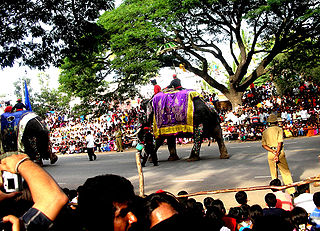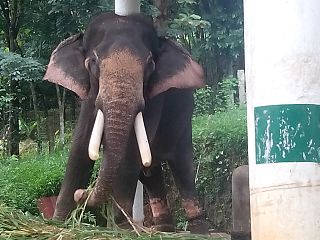 W
WAalavattam is a special decorative circular shield or fan that is held beneath both sides of respectable idols, deities or mythological characters during festivals and dances, especially in the state of Kerala in South India. The object is peculiar to the state of Kerala in India and the name originates from Malayalam (ml).
 W
WAiravata is a white elephant who carries the deity Indra. It is also called 'abhra-Matanga', meaning "elephant of the clouds"; 'Naga-malla', meaning "the fighting elephant"; and 'Arkasodara', meaning "brother of the sun". 'Abhramu' is the elephant wife of Airavata. Airavata has ten tusks and five trunks and is spotless white. Airavata is also the third son of Iravati. In the Mahabharata he is listed as a great serpent.
 W
WArjuna is an Asian elephant who, from 2012 to 2019 has been the lead elephant and the carrier of the Golden Howdah at the Mysore Dasara. He was named after Arjuna, the third of the Pandava brothers from the Hindu epic Mahabharatha.
 W
WThe parable of the blind men and an elephant originated in the ancient Indian subcontinent, from where it has been widely diffused. It is a story of a group of blind men who have never come across an elephant before and who learn and imagine what the elephant is like by touching it. Each blind man feels a different part of the elephant's body, but only one part, such as the side or the tusk. They then describe the elephant based on their limited experience and their descriptions of the elephant are different from each other. In some versions, they come to suspect that the other person is dishonest and they come to blows. The moral of the parable is that humans have a tendency to claim absolute truth based on their limited, subjective experience as they ignore other people's limited, subjective experiences which may be equally true.
 W
WChirakkal Kalidasan is a famous elephant, tallest elephant in Kerala because he is the tallest elephant in India.
 W
WElephants have been depicted in mythology, symbolism and popular culture. They are both revered in religion and respected for their prowess in war. They also have negative connotations such as being a symbol for an unnecessary burden. Ever since the Stone Age, when elephants were represented by ancient petroglyphs and cave art, they have been portrayed in various forms of art, including pictures, sculptures, music, film, and even architecture.
 W
WElephants are an integral part of the Mysore Dasara Festival. The elephants form the core of the Mysore Dasara procession on the Vijayadashami day. The lead elephant carries the Golden Howdah with the Goddess Chamundeshwari in it. The Golden Howdah weighs 750 Kilograms in weight and is purely made of gold.
 W
WElephants found in Kerala, the Indian elephants, are one of three recognized subspecies of the Asian elephant. Since 1986, Asian elephants have been listed as endangered by IUCN as the population has declined by at least 50% over the last three generations, estimated to be 25,600 to 32,750 in the wild. The species is pre-eminently threatened by habitat loss, degradation and fragmentation. Along with a large population of wild elephants, Kerala has more than seven hundred domesticated elephants. Most of them are owned by temples and individuals. They are used for religious ceremonies in and around the temples, and some churches, and a few elephants work at timber yards.
 W
WExecution by elephant was a common method of capital punishment in South and Southeast Asia, particularly in India, where Asian elephants were used to crush, dismember or torture captives in public executions. The animals were trained and versatile, able to kill victims immediately or to torture them slowly over a prolonged period. Most commonly employed by royalty, the elephants were used to signify both the ruler's absolute power and his ability to control wild animals.
 W
WGajasurasamhara, also Gajasamhara, Gajantaka and Gajaha and Matangari, is a fierce aspect of the Hindu god Shiva as the Destroyer of the elephant demon, Gajasura. The icon is popular in Pallava and Chola art, which portray him dancing vigorously in the flayed elephant hide of Gajasura.
 W
WGajavidala is a motif in the architecture of India that depicts a lion overpowering an elephant.
 W
WThe Gajendra Moksham mural painting in the Krishmapuram palace is considered the largest single panel mural of Kerala.
 W
WGanesha (Sanskrit: गणेश, IAST: Gaṇeśa, also known as Ganapati and Vinayaka, is one of the best-known and most worshipped deities in the Hindu pantheon. His image is found throughout India, Nepal, Sri Lanka, Thailand, Indonesia, Singapore, Malaysia, Philippines, and Bangladesh and in countries with large ethnic Indian populations including Fiji, Guyana, Mauritius, and Trinidad and Tobago. Hindu denominations worship him regardless of affiliations. Devotion to Ganesha is widely diffused and extends to Jains and Buddhists.
 W
WGajarajan Guruvayur Keshavan is perhaps the most famous and celebrated temple elephant in Kerala, India. Keshavan was donated to the Guruvayur temple by the royal family of Nilambur on 4 January 1922.
 W
WThe Hastividyārnava, written by Sukumar Barkaith, is one of the best known illustrated manuscripts of Assam. Commissioned under the patronage of King Siva Singha and his queen consort Phuleswari, it deals with the management and care of elephants in the royal stables.
 W
WThe Kaziranga Elephant Festival is a yearly elephant festival held in the Kaziranga National Park of Assam for the conservation and protection of Asiatic elephant. The festival is jointly organised by the Forest Department and Tourism Department of Assam with an objective to highlight and find ways to resolve the increasing man-elephant conflict. Hundreds of domestic Asiatic elephants, decorated from head to toe, participate in the program. They take part in parade, races, football and dance earning praises from the spectators.
 W
WA khedda or the Khedda system was a stockade trap for the capture of a full herd of elephants that was used in India; other methods were also used to capture single elephants. The elephants were driven into the stockade by skilled mahouts mounted on domesticated elephants. This method was practiced widely in North-east India, particularly in the state of Assam, mostly in South India, and in particular in the erstwhile Mysore State state.
 W
WKottur Soman is the oldest living elephant in the world, owned by the Kerala Forest Department.
 W
WKumki or Koomkie is a term used in India for trained captive Asian elephants used in operations to trap wild elephants, sometimes to rescue or to provide medical treatment to an injured or trapped wild elephant. The term may be more specifically applied to trained female elephants used as decoys. Kumkis are used for capturing, calming and herding wild elephants or to lead wild elephants away in conflict situations. The word is derived from Persian kumak which means "aid" and is in wide usage from Bengal to Tamil Nadu by mahouts.
 W
WA mahout is an elephant rider, trainer, or keeper. Mahouts were used since antiquity for both civilian and military use. Traditionally, mahouts came from ethnic groups with generations of elephant keeping experience, with a mahout retaining his elephant throughout its working life or service years. Mahouts would often ride on a howdah placed on the back of their elephant.
 W
WMatanga Lila is a treatise in Sanskrit dealing with the life and behaviour of elephants. The title has been translated as Elephant-sport. It is a treatise in 263 stanzas divided into twelve chapters of varying length. In the treatise, the author's name has been mentioned as Nilakantha, but nothing more is known about the author. From the popularity of the text in the region now comprising the modern state of Kerala in India, it is thought that the author might have lived there. Also, nothing definite is known about the date of the work.
 W
WMela shikar is a traditional method of capturing wild elephants for captive use. These methods get employed in Burma, Thailand, Vietnam, Laos and Cambodia and in Assam in India. The process involves lassoing a wild elephant from the back of a trained one, called a koonki. This practice is prevalent in the northeastern part of India, especially in Assam, and is one of the methods seen in ancient India. Other traditional elephant capture methods include: khedda, byle shikar, snaring, pit method, and decoying by using a female koonki to lure a male elephant. Mela shikar used to be organized twice a year – after Durga Puja and during Bihu.
 W
WNettipattam is an ornament used in Kerala and Tamil Nadu to decorate temple Elephants(aka:Caparison). Elephants wear it on its forehead. Nettipattam is made with Gold and Copper. It is an integral part of Kerala culture. Nettipattam and Muthukkuda are a contribution of Buddhism. There are different types of Nettipattam like Chooralpoli, Nagapadam, Vendod, etc. Although it is commonly known as Nettipattam, it is called Thalaikkettu in temples.
 W
WGajarajan Pampady Rajan also written as Pampady Rajan is the most beautiful elephant in Kerala.
 W
WTemple elephants are a type of captive elephant. Many major temples own elephants; others hire or are donated elephants during the festive seasons. Temple elephants are usually wild animals, poached from the forests of North East India from wild herds at a young age and then sold into captivity to temples. Their treatment in captivity has been the subject of controversy and condemnation by some, while others claim that elephants form a vital part of the socio-economic framework of many temple ceremonies and festivals in India, particularly in the South.
 W
WThechikkottukavu Ramachandran is an elephant owned by Thechikottukavu devasom, a temple in Kerala. Standing at 316 cm, he is the tallest living captive elephant in India and the second in Asia. Ramachandran is fondly known among elephant lovers as Raman and enjoys a huge fan following across Kerala. Ramachandran is also given the title name of Ekachatradhipathi by his fans.
 W
WThiruvambadi Sivasundar was an Indian elephant who lived at the Thiruvambadi Sri Krishna Temple in Thrissur, Kerala, India.
 W
WThrikkadavoor Sivaraju is an elephant from southern Kerala owned by Travancore Devaswom. At an height of 311 cm, Sivaraju is one of tallest living elephants from Kerala.
 W
WVināyakī is an elephant-headed Hindu goddess. Her historical and iconography are not clearly defined. Little is told about her in Hindu scriptures and very few images of this deity exist.